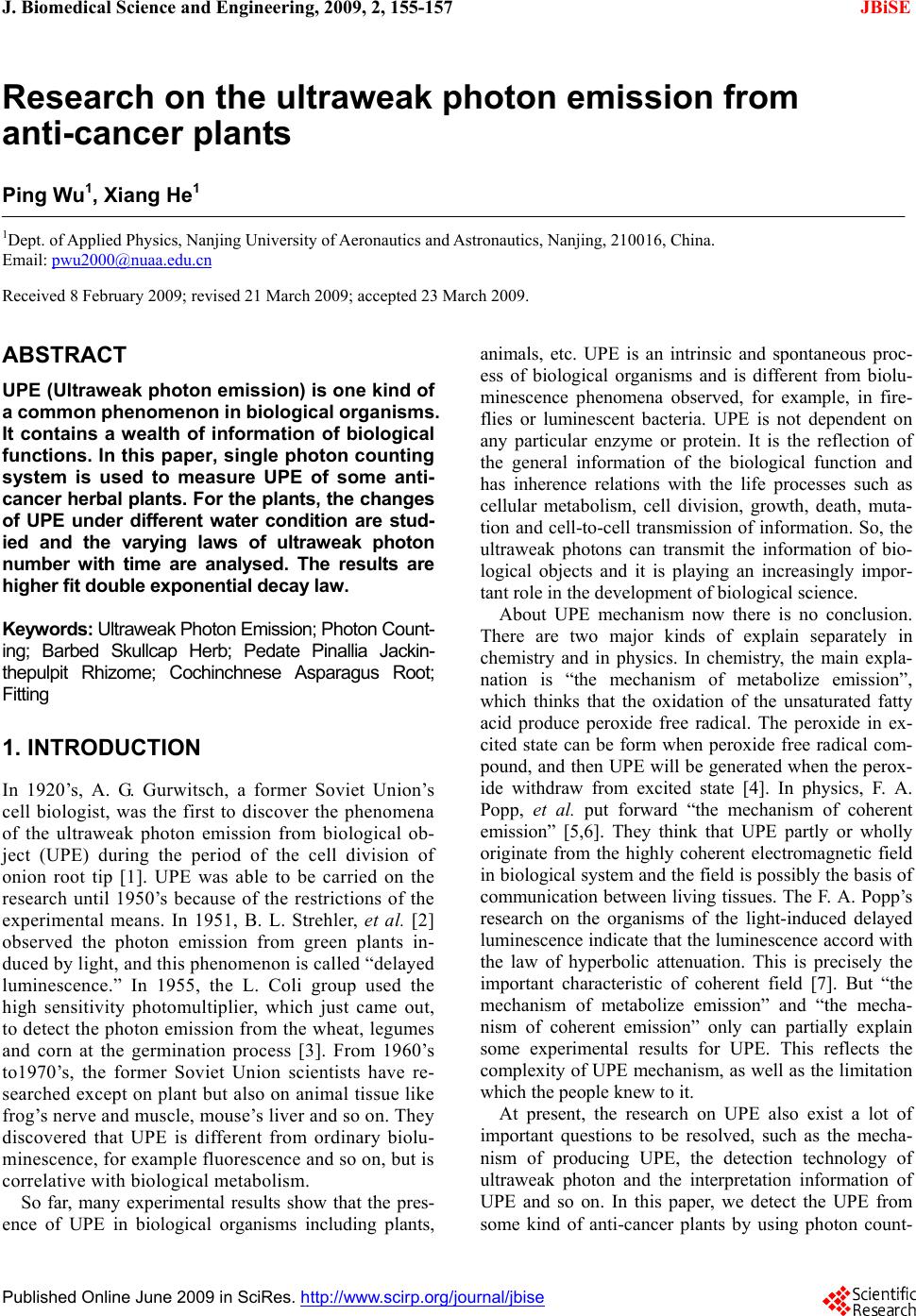
J. Biomedical Science and Engineering, 2009, 2, 155-157
Published Online June 2009 in SciRes. http://www.scirp.org/journal/jbise
JBiSE
Research on the ultraweak photon emission from
anti-cancer plants
Ping Wu1, Xiang He1
1Dept. of Applied Physics, Nanjing University of Aeronautics and Astronautics, Nanjing, 210016, China.
Email: pwu2000@nuaa.edu.cn
Received 8 February 2009; revised 21 March 2009; accepted 23 March 2009.
ABSTRACT
UPE (Ultraweak photon emission) is one kind of
a common phenomenon in biological organisms.
It contains a wealth of information of biological
functions. In this paper, single photon counting
system is used to measure UPE of some anti-
cancer herbal plants. For the p lants, the changes
of UPE under different water condition are stud-
ied and the varying laws of ultraweak photon
number with time are analysed. The results are
higher fit double exponential decay law.
Keywords: Ultraweak Photon Emission; Photon Count-
ing; Barbed Skullcap Herb; Pedate Pinallia Jackin-
thepulpit Rhizome; Cochinchnese Asparagus Root;
Fitting
1. INTRODUCTION
In 1920’s, A. G. Gurwitsch, a former Soviet Union’s
cell biologist, was the first to discover the phenomena
of the ultraweak photon emission from biological ob-
ject (UPE) during the period of the cell division of
onion root tip [1]. UPE was able to be carried on the
research until 1950’s because of the restrictions of the
experimental means. In 1951, B. L. Strehler, et al. [2]
observed the photon emission from green plants in-
duced by light, and this phenomenon is called “delayed
luminescence.” In 1955, the L. Coli group used the
high sensitivity photomultiplier, which just came out,
to detect the photon emission from the wheat, legumes
and corn at the germination process [3]. From 1960’s
to1970’s, the former Soviet Union scientists have re-
searched except on plant but also on animal tissue like
frog’s nerve and muscle, mouse’s liver and so on. They
discovered that UPE is different from ordinary biolu-
minescence, for example fluorescence and so on, but is
correla tive w i th b iolog ic al metab ol ism.
So far, many experimental results show that the pres-
ence of UPE in biological organisms including plants,
animals, etc. UPE is an intrinsic and spontaneous proc-
ess of biological organisms and is different from biolu-
minescence phenomena observed, for example, in fire-
flies or luminescent bacteria. UPE is not dependent on
any particular enzyme or protein. It is the reflection of
the general information of the biological function and
has inherence relations with the life processes such as
cellular metabolism, cell division, growth, death, muta-
tion and cell-to-cell transmission of information. So, the
ultraweak photons can transmit the information of bio-
logical objects and it is playing an increasingly impor-
tant role in the development of biological science.
About UPE mechanism now there is no conclusion.
There are two major kinds of explain separately in
chemistry and in physics. In chemistry, the main expla-
nation is “the mechanism of metabolize emission”,
which thinks that the oxidation of the unsaturated fatty
acid produce peroxide free radical. The peroxide in ex-
cited state can be form when peroxide free radical com-
pound, and then UPE will be generated when the perox-
ide withdraw from excited state [4]. In physics, F. A.
Popp, et al. put forward “the mechanism of coherent
emission” [5,6]. They think that UPE partly or wholly
originate from the highly coherent electromagnetic field
in biological system and the field is possibly the basis of
communication between living tissues. The F. A. Popp’s
research on the organisms of the light-induced delayed
luminescence indicate that the luminescence accord with
the law of hyperbolic attenuation. This is precisely the
important characteristic of coherent field [7]. But “the
mechanism of metabolize emission” and “the mecha-
nism of coherent emission” only can partially explain
some experimental results for UPE. This reflects the
complexity of UPE mechanism, as well as the limitation
which the people knew to it.
At present, the research on UPE also exist a lot of
important questions to be resolved, such as the mecha-
nism of producing UPE, the detection technology of
ultraweak photon and the interpretation information of
UPE and so on. In this paper, we detect the UPE from
some kind of anti-cancer plants by using photon count-